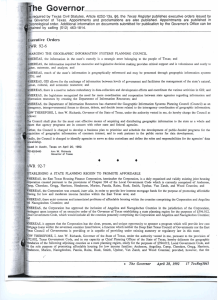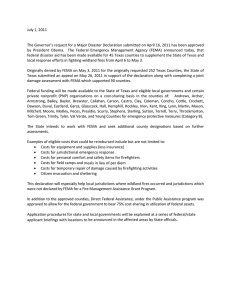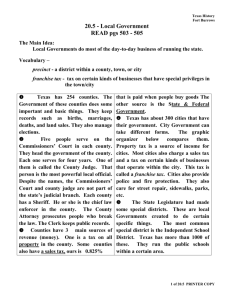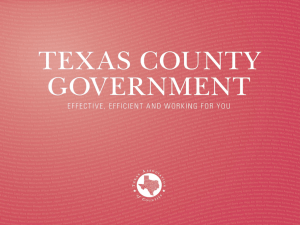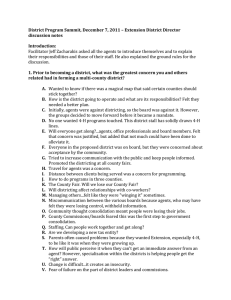County Government in Texas
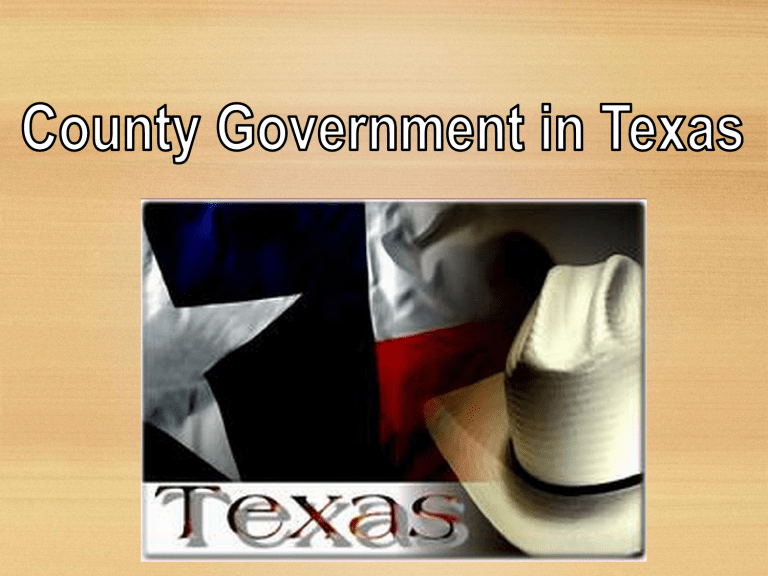
Local Government in Texas
• Local officials should be easily accountable to the public.
• Conditioned upon public and media attention
• More time cost to follow local news and politics
• Easier to keep informed of higher offices
• High volume of national media coverage in virtually all outlets, including local news
County Government in Texas
• Texas has more than 4,835 local governments.
• That is *a lot* of government for a state so much associated with limited and small government.
• 254 county units
• 1,209 municipal (cities) units
• 1,082 school districts
• 2,291 special districts
• Ex.: water, utility, community college, hospital
County Government in Texas
• More authority in sparsely populated areas
• Administer state laws (do little legislation)
• Historical origins, began as “ municipalities ”
• 1835, 23 municipalities
• 1836, Republic of Texas changes name to
“counties”
• 1921, there were 254 counties (same as today)
County Government in Texas
• County commissioners court
• Main governing unit of the county
• Sets budget and county tax rate
• County may not legislate much, but tax rates certainly impact local residents, business, and industry
• Composition
• One county judge
• Four county commissioners
Countywide and Precinct-Level
Elected Officials
County Government in Texas
• County judge
• Elected countywide
• Four-year terms, no limits
• In rural counties, may also serve as actual judge
• Most cases is administrator for the county
• County commissioners
• Elected by geographic districts
• Each one-quarter of county
• Four-year terms, no limits
The County Commissioners Court
Primary Functions of County
Government
County Government in Texas
• County government responsibilities
• Maintain roads, bridges, and county jails
• Cover some health care costs for indigent
• Large counties maintain public facilities
• Libraries, parks, or public hospitals
• Assist with natural disaster logistics and costs
• Administer all elections in the county
• No matter the offices on the ballot, counties are responsible for election administration
County Government in Texas
• County government responsibilities, staff, and resources vary dramatically
• Reflect population and land size differences
• Compare
• Loving County: pop. 94; size 681 sq. mi.
• Harris County: pop. 4.2 million; size 1778 sq. mi.
• Medium and small counties vulnerable
• Natural disasters, costly trials can exhaust budget
Functions of County
Government
• Five main functions of county government
1.
Road and bridge construction and maintenance
2.
Law enforcement
3.
Dispute resolution
4.
Record keeping
5.
Social services
Functions of County
Government
• Law enforcement
• Sheriff: chief county law enforcement officer
• Provide deputies for courthouses
• Maintain county jails
• County and district courts
• Attorneys for county and district
• DAs typically handle the more serious crimes.
• County prosecutors take less serious cases.
• In smaller counties, duties are not split in that fashion.
Functions of County
Government
• County clerks keep records.
• Vital stats for county (births, deaths, marriages)
• Issue licenses (driving, marriage)
• Maintain court records
• Record property transactions
• Dispute resolution
• Justice of the peace, county and district courts resolve civil disputes
Functions of County
Government
• Counties may provide a range of services.
• Some of them are a matter of administering federal- and state-funded programs
• Nutrition and housing assistance
• Health care (including mental health)
• Public health monitoring and records
• Public parks
• Fire and sanitation

